Ah, the zoo; a fun filled family environment to bring your family to visit… your family. Just kidding about that last part, but the fact remains that many people do believe in evolution. My parents may read this and immediately become angry. However, it is not my intention to offend creationists or evolutionists alike. As Darwin provided evidence, life is comprised of many genetic mutations over the course of time evolving from the simplest life forms into where we are today. And that takes us back to the zoo and visiting relatives.
On a particularly nippy late spring day, my family and I headed north to the Woodland Park Zoo in Seattle, one of our favorite haunts. Like so many other adults, I was raised in a strict religious home (in the past, some friends of mine have used the word ‘zealot’). We were taught that animals were put on this earth to entertain us, serving no other purpose. Not seeing the ‘value’ in going to the zoo very often, we only visited once or twice, never learning the importance of each species survival. Becoming globally aware of our planet and its inhabitants, my husband, Erik, and bonus son, Bjorn, and I make frequent trips to the zoo in an effort to learn all we can and to make ‘contact.’
Being mindful and respectful of other guests, we approach the divider and observe the animal, hopeful that the animal will in turn engage us. By ‘engage us’ I’m mainly referring to primates. Careful to not make eye contact (in primates, it’s seen as a sign of aggression and dominance); make quick glances to the primate, trying to mimic their actions and catch their eye. Studying primates has given me greater insight as to how closely we are related and it’s this realization that has fueled my desire to help protect the species.
CEO’s of many zoos cannot stress enough the importance of having visitors engage with the animals, as it not only provides a greater experience, but develops a deeper responsibility toward our environment.
Reaching the Siamang enclosure, we discovered a break in the wave of people and took this unique opportunity to simply enjoy the captivated nature. On a prior visit, Erik took an amazing photo of the male Siamang, Simon, and it sits just below my computer screen. Often, I gaze into his eyes and realize that we are truly very much alike. As Bjorn bent to tie his shoe, I crouched down near the glass and looked for a familiar face. Within a minute, Simon came up to where I sat. Surprised, I smiled (careful not to show teeth) and began taking notes, but was quickly interrupted as I heard a sharp voice coming from behind.
Startled, I turned to see a docent standing before me, with her hands on her hips, a deeply etched scowl upon her face, and scolding me as if I were a wayward two year old. Even though all I had done was crouch down, notebook visible, and smile, she berated and belittled me for ‘interfering with the mating process.’ Nothing gathers a crowd a faster than one primate verbally bashing another and by now, the area was packed.
Apparently, the zoo was taking great measures to encourage Simon mate with a much younger female and any outside distraction was disrupting their hopeful success. And needless to say, at that moment, I was the source of Simon’s distraction. What can I say? I just have this irresistible, animalistic nature that primates just can’t resist. Speechless and mortified, I stood there and took her verbal assault. As she stalked away, the three of us looked in vain for any indication that the Siamangs were off exhibit, but found none. With our spirits dampened, we decided to call it a day, despite the early hour.
Days had passed and the more I thought of what happened, the angrier I became. Deciding to address the situation, I composed a professional letter to the head of the zoo, explaining the events, my feelings, as well as providing the evidence of why it is so important for visitors to be engaged with the animals on exhibit. I promptly received a reply that was, to be honest, shocking.
Along with apologizing profusely, they promised to address the situation with the docent immediately, as well as all of the staff, and we were given a full year paid membership to the zoo. If that weren’t enough already, they offered us deal we couldn’t refuse – a behind the scenes tour of the elephants and giraffes, feeding included. We assumed the ‘feeding’ would entail us feeding the animals, rather than us being the main course; there are other ways of dealing with blabber mouths like me. Astonished, I thanked them for their incredible generosity and stated that we truly did not expect such grand gestures, but I merely wanted them to be aware of the situation.
The date of our tour arrived and we were greeted by Anne Knapp, one of the loveliest ladies I’ve ever met. Her warm smile, enthusiasm and passion for the animals at the zoo, as well as the visitors, were evident. Ensuring that we had our camera ready, we set off toward our first enclosure, the elephants.
Introductions were made and we followed the keepers into the back of the Holding Barn, a view we’d seen many times prior, but from the other side. An enclosed, open area viewable to the public, it serves many purposes, but this morning it was for bathing, which doubles as a routine examination.
Having been introduced to Watoto, a female African elephant born between 1969 and 1970 in Kenya, the keepers began their task, discussing the importance of the species they love so much, and answering the plethora of questions we threw at them.
Many cultures believe the elephant is the symbol of wisdom, given their intelligence mimicking humans. With a life span of 50 to 70 years, and gestation of 22 months, their continued existence is critical. Standing between nine to ten feet in height and weighing around an average of 7,700 pounds, the African elephants environmental destruction maintain the survival of an unfathomable amount of species. To put it simply, they plow the land owned by the community, enabling others members (such as giraffes, dikdik’s, and Impala’s) to feed upon the younger Acacia trees that would have died if the elephants hadn’t knocked down the older, taller trees, shadowing the younger.
The Thompson’s Gazelle, cheetah’s, leopards, and lions all benefit from the vast openness of the Savannah that the elephants ‘gardening’ and ‘pruning’ of trees that would grow to detrimental heights, thus starving the giraffes, too. By keeping the flora in check, the elephants stabilize an ecosystem that would crumble and set a domino effect in motion that would affect you and me, on the other side of the planet.
Spending time with Watoto, feeding her treats and learning of her environment and wisdom, it is easy to acquire the sense of protection needed before her wild family vanishes. Taking our newfound knowledge, we continued along the same path toward the giraffes to finish our tour.
Standing atop an elevated platform, we were greeted by the curious faces of these elegant and graceful mammals. The keepers were lovely, too. A giraffe’s average height is between 15 and 18 feet tall and we immediately understood why elephants are so very important. Being picky eaters, favoring mainly acacia trees and only occasionally consuming other various trees or shrubs, we comprehend the need for selective pruning, all the while reseeding, with a rather large shot of, uh, fertilizer. In the Savannah, it seems nothing goes to waste. While giraffes aren’t in any danger of becoming threatened, they are like us, depending upon other species for survival and it is this link that bonds each species together.
With our tour completed and our minds opened to the world around us, we walked away, set to explore the rest of the planet located on 92 acres. Stopping briefly to say hello to Simon, we each said thanks in our own way for the opportunity he brought us to help save the planet. And I said a special thanks to the docent who, in her own uniqueness, reminded me that the survival of every animal, great and small, is crucial, before the human race becomes extinct.
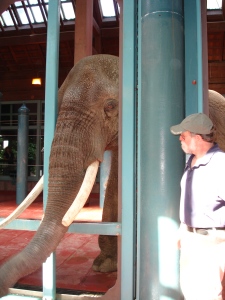
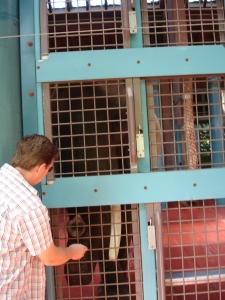
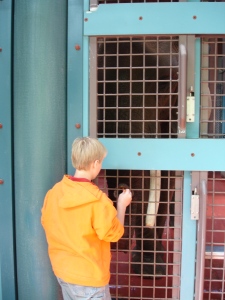
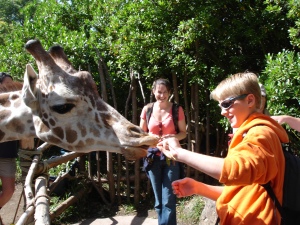
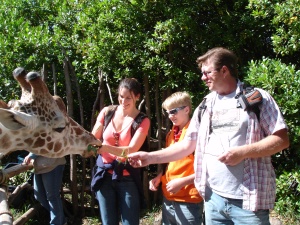
Just want to say what a great blog you got here!
I’ve been around for quite a lot of time, but finally decided to show my appreciation of your work!
Thumbs up, and keep it going!
Cheers
Christian
By: Royanigittawn on May 15, 2010
at 2:11 pm
A very nice article, indeed! We in Germany often discuss about if it’s right to have such institutions, because the animals are “imprisoned” here. On the other hand, as your writings show in an impressive way, it is necessary to get in touch with the wild creatures to understand their kind and see natures richness. It is not only sad, if this variety gets lost, it’s dramatic…
By: Peer Spektive on May 17, 2010
at 5:43 am
Peer, you are absolutely correct; the animals are imprisoned. And as humans we view it as cruel and “inhumane,” especially if the zoo is lacking enrichment; we begin to witness stress and mental illness in the more intelligent species.
Zoo’s only offering an enclosure constructed of cold harsh steel and concrete, that would be devastating to any animal with higher intelligence. Fortunately I regret to say that most animals we find in zoo’s are not brought in from the wild rather have been born in captivity, in one fashion or another (the regret comes from that many of these animals come from private collections) and would not function in their perspective homes in the wild anyway and are more accustomed to life behind bars.
With that thought in mind, for my own justification if you will, I see the animals in the zoo as ambassadors for people around the world who are unable to travel to theses native habitats. The zoo is a place to offer education to our citizens locally and globally on what is transpiring in some of the most sensitive and/or weakened environments. Education that offers advice on how to make better choices in their lives – from what products they should and shouldn’t purchase to how to vote for their leaders. However if a zoo in your area is still one of cold steel and concrete I encourage you to contact them and let them know the enrichment that the Woodland Park Zoo offers their animals. It is probably as close to being free one can get while being imprisoned.
At the very least, stress and mental illness doesn’t seem to be an issue from what I have witnessed and I doubt the animals put on a show just for me. Additionally some these animals are so endangered that some barely exist at all in the wild and they may represent the only genetic information available. Hence if their species has a chance in the future when humanity can stop destroying our planet it might be with these few specimens preserving their entire species.
Maybe someday our grandchildren or great grandchildren can abolish the need for zoos with the preservation of the planet, but for awhile longer we need the awareness and the constant reminder to help our species make better choices for the planet we share.
By: destinationwashington on May 17, 2010
at 8:35 am
Hello destinationwashington,
you’re totally right. In my hometown Dresden we only have a small zoo in the middle of the city. Though it got reconstructed step by step in the last years in my opinion it’s to small to serve as a good living environment. In my point of view it should change to a wild park with only some species, mostly native ones. This would be the best choise for a lot of this institutions…
http://www.zoo-dresden.de/
By: Peer Spektive on May 17, 2010
at 11:38 pm